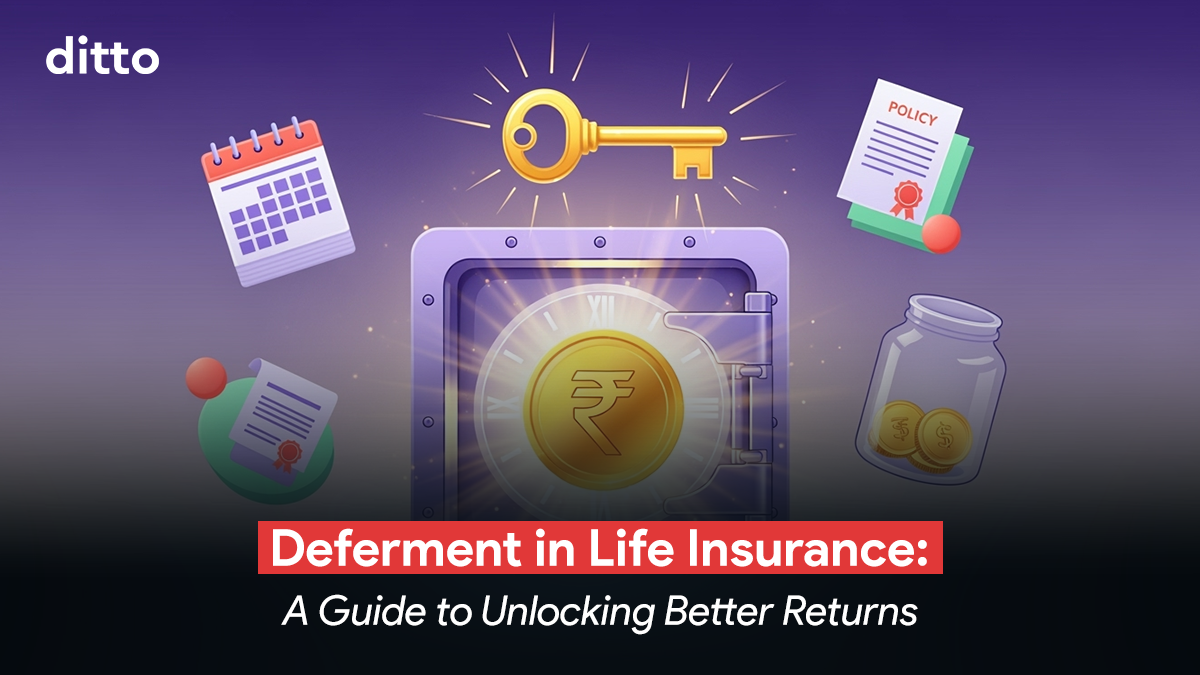| What is a Deferment Period in Life Insurance? A deferment period in life insurance is the time between the policy purchase and the start of benefits. During this phase, you continue paying premiums or may have paid them upfront (lump sum), but no payouts are made. Once the deferment ends, the insurer provides regular income, such as annuity payments, as outlined in the policy. This feature is common in pension, annuity, and guaranteed income or savings plans. Policyholders choose how long to defer income, and generally, the longer the deferment, the higher the eventual payouts, since the insurer has more time to grow the invested funds. |
Planning your financial future isn’t just about purchasing the correct policy; it’s also about deciding when to start receiving the policy benefits. Here, the deferment period comes into play and lets you delay payouts, giving your money more time to grow.
This guide will explain how deferment works in ULIPs, annuities, and savings plans, its benefits, IRDAI guidelines, and how to pick the correct deferment period based on your financial needs and life stage.
You can book a FREE consultation. Slots are running out, so make sure you book a call now!
| Did You Know? 1) Deferred annuities let your money grow tax-free during deferment and then pay you a guaranteed steady income for life, but you can't access funds early. 2) NPS offers flexible investing with partial withdrawals, allowing up to a 60% lump sum at retirement but the remaining 40% can only be withdrawn via regular income (annuities). 3) Mutual Fund SWPs let you withdraw anytime without a fixed deferment, but don't guarantee returns. Choose whether you want guaranteed income, flexibility, or market-linked growth. |
Where is Deferment Period Applicable?
The deferment period typically applies to insurance + investment plans where payouts are delayed to better match your financial goals. It's beneficial when you want your money to grow before receiving income.
You'll commonly find deferment options in:
- ULIPs (for long-term market linked wealth creation + protection)
- Annuity/pension Plans (for retirement income, often the most used)
- Endowment Plans (especially child-focused savings)
- Money-Back Plans (for periodic income needs)
The deferment period lets you voluntarily delay your benefits, helping you accumulate more value before the payout phase begins, which is ideal for retirement or long-term income planning.
| Did You Know? 1)The deferment period isn’t just about “waiting for income.” IRDAI has built clear rights and options for customers: 2) Nominees can choose how to receive the money if the policyholder dies during the deferment period. 3) Option to convert the lump sum into regular income (annuity) or choose from different annuity providers. 4) Policyholders can make limited partial withdrawals, depending on the policy terms. 5) In ULIPs, you can extend the deferment period if you want to delay receiving the benefits. 6) You may also get a loan against the policy if you need money during the deferment period. |
How Does the Deferment Period Work?
You pay regular premiums during the policy term. When your policy matures and you're eligible to start receiving benefits or payouts, you can defer them instead of beginning payouts immediately. During this deferment period, the policy stays active, and your benefits may grow without additional premium payments.
Let’s see how the deferment Period works:
A person purchases an annuity plan at 50, while the spouse still earns, and the purchase price is 50 Lakh.
Now the person has two options:
- Immediate Annuity- If the person chooses this option, a monthly income of ₹ 27000 for life.
- Deferred Annuity- If the person chooses a deferred annuity, say 10 years (the spouse too stops earning), the policyholder will draw a monthly payment of ₹44000.
Therefore, opting for the deferred annuity option, the person receives ₹ 17,000 extra per month, as the 10-year waiting period allowed the funds to grow.
Let’s see how this works in ULIPs and Annuities:
- In a Unit-Linked Insurance Plan (ULIP), deferment refers to the option to delay withdrawals beyond the 5-year lock-in period.
ULIPs have a mandatory 5-year lock-in, during which you cannot withdraw or surrender your funds. If you exit early, the amount is moved to a discontinued fund and only paid out after five years.
Examples:
In a standard ULIP, such as ICICI Protect N Gain, there isn’t a formal “deferment period” built into the plan. Instead, you could choose a limited premium payment option (say, pay for 10 years) and then let the policy continue for the full 20–30 year term without withdrawing. This acts like a voluntary deferment, since your money stays invested and keeps compounding until you decide to take it out.
By contrast, the pension ULIP, such as ICICI Signature Pension, works differently: you select a vesting age or date at the start, which is the official deferment period. During this time, your premiums accumulate in the pension fund. Once the deferment period ends, you can withdraw up to 60% of the accumulated amount as a lump sum. The remaining 40% must be used to purchase an annuity, which provides regular income per IRDAI rules.
In short, a standard ULIP gives you flexibility to self-defer, while a pension ULIP enforces deferment by design to secure retirement income.
- The deferment period in annuities allows your money to grow for a larger retirement income. Typically, you pay a lump sum (purchase price) upfront and choose a deferment duration at inception. During this accumulation phase, some plans credit monthly guaranteed additions, while others add a fixed percentage each year plus a vesting addition at maturity.
Examples:
In the ICICI Pru Guaranteed Pension Plan, your investment earns guaranteed additions every month for 1–10 years, after which the amount is converted into a fixed lifelong annuity.
In contrast, the HDFC Life Guaranteed Pension Plan gives you guaranteed returns of 3% every year, plus a bonus at the end of the policy term (which can be between 8 and 40 years). When the plan matures, you can withdraw up to 60% of the total amount as a lump sum and use the rest to buy a regular income (annuity). You also have the option to purchase part of this annuity from another insurance company.
If the policyholder dies during deferment, nominees typically receive either the purchase price plus accrued additions or at least 105% of the purchase price, with plans like LIC New Pension Plus 867 also offering the option to withdraw the corpus or buy an annuity for the nominee.
For instance, a 40-year-old investing ₹10 lakh could choose to start a lifelong guaranteed annuity at age 50 with ICICI, following a 10-year deferment.
Alternatively, they could choose the HDFC Life Guaranteed Pension Plan, where their money keeps growing until age 60 through yearly guaranteed additions and a final bonus. At that point, they can take part of the money in cash and use the rest to get a regular income for life.
In essence, deferment serves as a bridge between investment and retirement. ICICI Prudential focuses on locking in annuity rates early, while HDFC Life emphasizes growing the retirement corpus before initiating income.
What Are the Benefits of Deferment Periods?
Choosing the correct deferment period offers several advantages:
- Higher annuity income: Longer deferment often means the insurer can invest your premiums for longer before paying you. That growth leads to larger monthly or yearly payouts.
- Better alignment with retirement goals: If you don't need income immediately (e.g., you have other income sources), you can delay payouts. Hence, they begin when you're older and have fewer expenses.
- Tax advantages: In many cases, the deferment period acts like an accumulation phase (for pension ULIPs or Deferred annuity plans), possibly giving you tax deferral on growth until payouts begin.
- Flexibility: It lets you plan better, you can pick a deferment period that matches when you expect retirement or need the most income.
| Did You Know? As per IRDAI guidelines, you can make partial withdrawals during the deferment period, but only after 3 years of the policy start date, and up to 25% of the total premiums paid. |
What Factors Affect Deferment Period in Life Insurance?
The deferment period, especially in annuity or savings-based policies, impacts your returns and the time you begin receiving payouts. Choosing the right duration depends on your financial goals, lifestyle needs, and risk appetite:
1. Your Financial Goals:
Start by identifying what you're saving for. Whether it's your child's education or retirement, a deferment period allows your funds to grow until you need them. Longer deferment can mean greater accumulation through compounding.
2. Need for Immediate Income:
If you'll need income soon after premium payments end, a shorter or zero-deferment period (as in immediate annuity plans) might be ideal for retirement or living expenses.
| Did You Know? The Saral Pension Yojana is a standardized, immediate annuity plan mandated by the Insurance Regulatory and Development Authority of India (IRDAI) and offered by all life insurance companies in India. It provides a guaranteed, lifelong pension in exchange for a single, lump-sum premium payment. |
3. Long-Term Growth Potential:
If you have other income sources and don't need immediate payouts, a more extended deferment period lets your investment grow more, potentially leading to higher future income.
4. Age and Health:
Your current age and health status play a role in determining the ideal deferment period.
- Young and healthy? You can afford to wait longer, allowing your money to compound.
- Older or managing health conditions? A shorter deferment might be better, giving you access to funds sooner.
5. Risk Tolerance:
The deferment period can influence the level of market risk exposure, particularly with market-linked annuity plans.
- Comfortable with market ups and downs? A more extended deferment (especially in market-linked plans) may yield better returns.
- Prefer stability? A shorter deferment offers more predictable outcomes and less equity market exposure.
In short, align your deferment period with your life stage, financial needs, and comfort with risk to get the most from your policy.
| Point to Be Noted As per IRDAI guidelines, Policyholders below 60 years can extend the deferment or accumulation period under the same terms as the original policy, offering added flexibility for retirement planning. |
How to Choose the Correct Deferment Period? (Ditto’s Take)
When it comes to choosing a deferment period, your family’s financial needs should be the top priority. Here are Ditto’s suggestions:
- Estimate when you will need the income (retirement, children finishing school, paying off debt). Don’t pick a deferment so long that you struggle before income starts.
- Ensure you have other income sources or savings to cover your needs during the deferment period.
- Check if the plan offers death benefit or return of purchase price during deferment, this protects loved ones if you pass away before payouts start.
- Compare how much extra income you get for each extra year of deferment — sometimes waiting a little longer gives a big boost; other times, the gain is small and not worth having no payouts for many years.
- Confirm minimum and maximum deferment limits from the insurer. Some plans let you choose 1–20 years, others tie it to premium payment terms. See what works for you.
| How do you choose between an immediate or a deferred annuity? If you need a steady income soon, an immediate annuity is a good choice as it turns your savings into regular payments. But a deferred annuity makes more sense if you’re still a few years from retirement and want your money to grow before getting paid. Choose based on when you’ll need the income and your plans. Also, an immediate annuity will fetch lower pensions than a deferred annuity. |
Why Talk to Ditto for Your Life Coverage?
At Ditto, we’ve assisted over 7,00,000 customers with choosing the right insurance policy. Why customers like Arun below love us:

✅No-Spam & No Salesmen
✅Rated 4.9/5 on Google Reviews by 5,000+ happy customers
✅Backed by Zerodha
✅100% Free Consultation
You can book a FREE consultation. Slots are running out, so make sure you book a call now!
Key Takeaways
Here are key points to keep in mind when evaluating life insurance plans with a deferment period:
- Complexity matters: Combo products (like ULIPs, annuities) often have high charges and complicated structures. Understand before investing.
- Need pure protection? Opt for a term plan with the highest coverage at the lowest cost.
- Want to grow wealth? Combine term insurance with mutual funds, PPF, FD, or NPS for better (low cost) returns and flexibility.
- ULIPs underperform: Due to internal costs, they often lag behind direct mutual fund investments.
Annuities offer lower returns: They typically yield less than FDs, PPF, SCSS, or debt mutual funds, especially post-tax.
FAQs
What is the Deferment Period?
The deferment period is the waiting time after you buy a policy before the benefits or payouts start. During this time, you may not claim money from the policy.
What is the Deferment Period in Life Insurance?
The deferment period in life insurance is the waiting time between purchasing the policy and when the coverage or benefits actually begin. During this time, specific claims or benefits may not be payable.
What happens if I die during the deferment period?
Most plans provide some benefit: either return of a part or full purchase price, or the nominee may choose immediate annuity or lump sum, depending on the policy. For example, in IndiaFirst Life Smart Retirement Plan , if death occurs during deferment, nominees get at least 105% of the purchase price.
Can I change the deferment period after I start the plan?
Usually, no. Deferment period is fixed when you purchase the policy. Changing it later may not be allowed or may affect premiums / annuity rates.
Does the deferment period affect my premium payments?
In most plans, you pay regular premiums during the deferment phase, but a longer deferment can sometimes reduce overall premiums required.
Last updated on:







